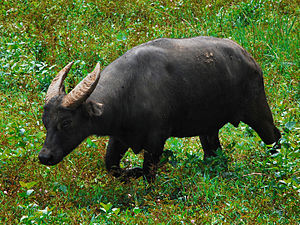Tamarau
| Tamarau | ||||||||||||
|---|---|---|---|---|---|---|---|---|---|---|---|---|

Tamarau ( Bubalus mindorensis ) |
||||||||||||
| Systematics | ||||||||||||
|
||||||||||||
| Scientific name | ||||||||||||
| Bubalus mindorensis | ||||||||||||
| Heude , 1888 |
The Tamarau ( Bubalus mindorensis , sometimes also written Tamaraw or Tamarao ) is an Asian buffalo that only occurs on the island of Mindoro, which belongs to the Philippines .
features
Tamaraus are much smaller and stockier than water buffalo . They reach a head body length of around 220 centimeters, a shoulder height of around 1 meter and a weight of 220 to 300 kilograms. Their fur is dark brown to black-gray in color. Both sexes have horns that are very thick, but with a length of 35 to 51 centimeters, they are much shorter than those of the water buffalo.
Way of life
Tamaraus once occurred on the entire island of Mindoro up to 2000 meters above sea level. They need forests or densely vegetated areas to rest and grasslands to eat. They lead a solitary way of life and can be active both day and night. It is possible that the nocturnal lifestyle observed today represents an answer to the disturbance of their habitat by humans. Tamaraus are herbivores that mainly feed on grasses.
After a gestation period of 276 to 315 days, the female gives birth to a single young. Young animals are initially reddish-brown in color, only when they are three to four years old do they reach the color of the fur of adults. They separate from their mother around the same age. Life expectancy is estimated at 20 to 25 years.
Tamaraus and people

The IUCN lists the Tamarau as " critically endangered ". The island of Mindoro is 9,735 km², but the Tamarau only inhabits two protected areas in the center, Mount Iglit Baco National Park , the area at Mount Aruyan, and the Mount Calavite Wildlife Sanctuary in Occidental Mindoro , which together cover less than 1,000 km² include. This wild cattle used to inhabit the entire island, and during the Pleistocene it was also native to neighboring Luzon . The reasons for the extensive population decline are poaching, forest destruction and infection with cattle diseases. To prevent extinction, the Tamaraw Conservation Program (TCP) was set up as Tamaraw Gene Pool Farm (GPF) in 1980 by the Department of Environment and Natural Resources (DENR - before 1987 DNR) of the Philippines. As part of the program, a 280 hectare breeding station was built in Barangay Manoot, in the municipality of Rizal . However, only one calf was born in the breeding station (1999). The population of the Tamarau is given by the DENR in 2011 with 274 and in 2012 with 327 animals (beginning of the annual census in 2000 with 154 animals). The aim is to increase the number of Tamaraus to 600 animals by 2020.
The tamarau is the largest wild land mammal in the Philippines. He has been there under full protection since 1936 and is considered a national symbol. It is depicted on some older Philippine 1 peso coin. The sports teams of Far Eastern University in Manila have the Tamerau in their coat of arms and are known as FEU Tamaraws UAAP teams.
Systematics
There was long disagreement about the systematic position of the tamarau. It was sometimes described as a subspecies of the water buffalo , then again as a close relative of the Anoas . New DNA analyzes now seem to establish that the Tamarau is an independent species that is much more closely related to the water buffalo than to the Anoas.
literature
- Ronald M. Nowak: Walker's Mammals of the World. The Johns Hopkins University Press, Baltimore 1999, ISBN 0-8018-5789-9 .
Web links
- Information from the Department of Environment and Natural Resources (DENR) of the Philippine government about the Tamraw Conversation Program (TCP)
- Information with photos and distribution map on ultimateungulate.com
- Bubalus mindorensis in the endangered Red List species the IUCN 2006 Posted by: S. Hedges, 2000. Retrieved on 11 May, 2006.